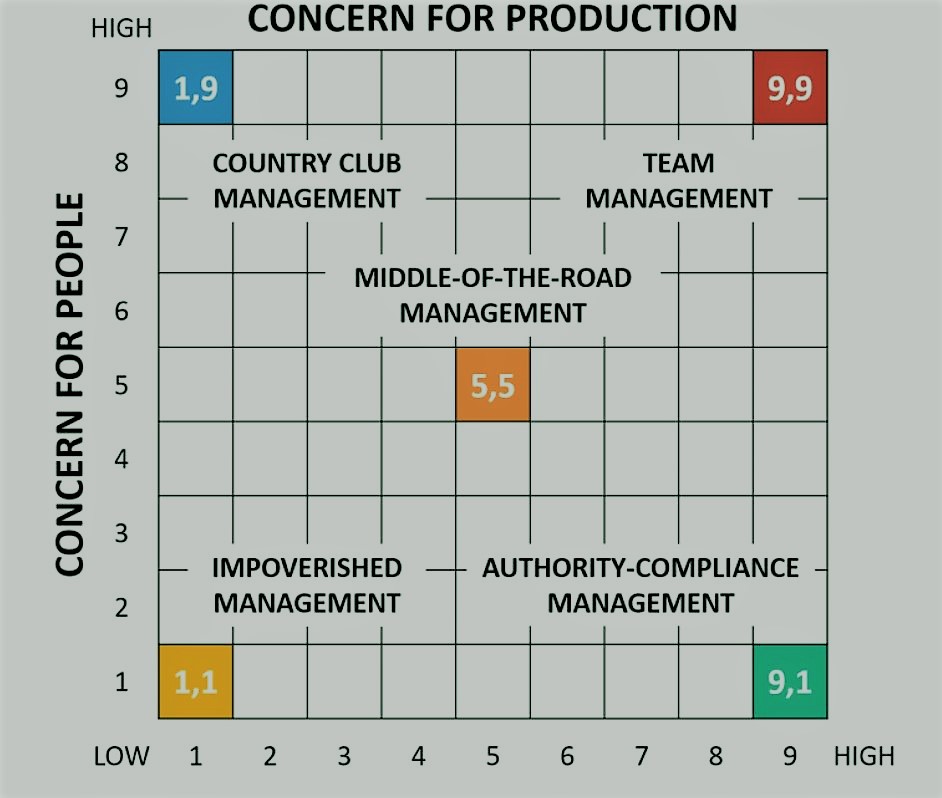What is Managerial Grid Theory of Leadership? Definition and Styles
What is Managerial Grid Theory of Leadership?
The managerial grid theory of leadership is a behavioral leadership theory proposed by Robert R. Blake and Jane S. Mouton in 1960 with the aim of explaining leaders’ behavior. According to Blake and Mouton, leaders’ behavior can be identified on the basis of their concern for people and production.
This leadership theory is also commonly referred to as the leadership grid since it portrays the leadership styles in a grid. They argued that a leader’s behavior can be a point in a grid. Where in the horizontal axis of the grid leaders are concerned with production and on the vertical axis leaders are concerned about people.
They took nine scales on each of these two dimensions i.e. concern for people and concern for production, which form 81 possible combinations called leadership styles. Among 81 possible leadership styles, the 5 key styles are impoverished leadership, country club leadership, task leadership, middle-of-the-road management, and team leadership.
Managerial Grid Leadership Styles
While defining leadership styles Blake and Mouton used 9 scales in which 1 means low and 9 means high in both concerns for people and production. The below picture depicts it clearly.

Let’s discuss each of the leadership styles of the leadership grid.
Related: The 12 Styles of Leadership
Impoverished Leadership Style (1,1)
Leaders with impoverished leadership styles show very little concern for both people and production. Such leaders can not satisfy the production requirements of the organization. They also do not care about the employee’s needs.
Country Club Leadership Style (1,9)
In the country club style, leaders have a high concern for people i.e. employees’ needs but have a low concern for production. This leadership style enhances the better leader-follower relationship, a good working environment, and job security.
In addition, this managerial grid model of leadership claims that for a higher level of employee satisfaction and loyalty, leaders should follow this country club style.
Middle of the Road Style (5,5)
Leaders with average concern for both people and production follow this style. Leaders with the middle-of-the-road style can balance productivity as well as good human relations in the organization. This is the best behavioral pattern of leadership to maintain organizational growth and employee loyalty.
Task Style (9,1)
Leaders with task styles have a high concern for production but a low concern for people. This style of leadership encourages the maximization of production but ignores the leader-follower relationship. As such, the task leadership style is not fit where maintaining good human relations is required.
Team Management Style (9,9)
Leaders with a team management style pay the highest concern for both production and people. As being concerned for people, employee satisfaction will be high, at the same with the maximum concern for production, production efficiency also remains high.
This style is the most effective leadership style among all the presented above in which a leader gives equally high concern for people and production. The leader can achieve high productivity through the participation and coordination of followers and the utmost use of their talents and skills.
Read Next: Ohio State Leadership
Sajan Kushmi is a content writer with more than 4 years of experience. He holds BIM Degree. He write on the topics related to Management, Marketing, and Entrepreneurship.







I really enjoyed the whole educative view on Human Relation as an employee I can clearly see where i stand in my workplace.
That’s great, Atonio.